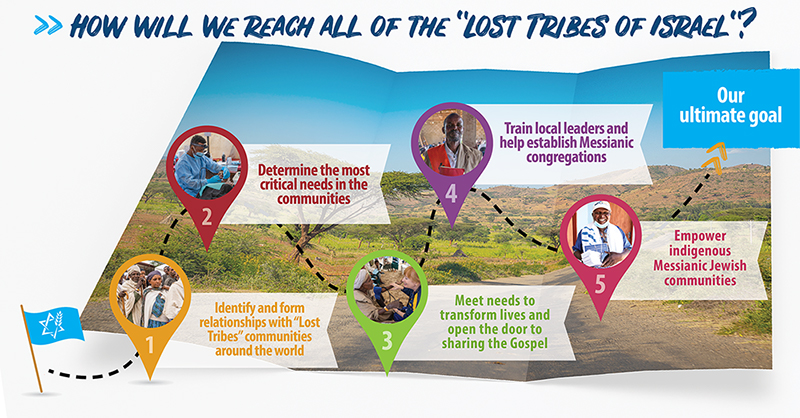How Do You Confirm a Jewish Community’s Claim to Be of the “Lost Tribes of Israel”?
The mythology of the “Lost Tribes” has led to many different groups claiming to be associated with the “Lost Tribes of Israel.” In some cases, dangerous theology has also been developed that claims their groups are the “real Israel” and diminishes the distinction between Jewish and non-Jewish followers of Yeshua that the Apostolic Writings (most commonly referred to as “The New Testament”) confirm and testify as essential to an apostolic community of faith, the “Church,” made up of Jew and Gentile alike.
However, there are many groups around the world that claim to be the people of Israel who were scattered at the time of the Assyrian or Babylonian exiles. In fact, almost all Jewish communities outside of Israel today are the result of the either of these exiles or the exile that occurred in the first and second centuries at the Roman destruction of the Temple and the destruction of Jerusalem, respectively.
In order to have a standard of identification in working with those who claim to be from the “Lost Tribes” and are not often recognized by the worldwide Jewish community, the JVMI team considers five primary factors. You might be surprised to know that DNA testing is not the first nor primary indicator we turn to. Instead, we first look at some other informative elements.
Oral history
A community’s solid oral history, passed from generation to generation adds weight to their claim of being of the “Lost Tribes of Israel.” Those among the groups that are associated with the “Lost Tribes” have maintained the story of their emigration from Israel and how they came to the land where they currently dwell. As we hear the same history shared by multiple recognized elders in the community, we understand that this is a people group who knows they are not originally from where they now live.
Traditions and religious practices
As we investigate a group asserting to be from one of the “Lost Tribes of Israel,” we also look at their traditions and religious practices. After their original scattering in the 5th and 6th centuries BCE, many Jewish people groups observed their faith in secret to avoid persecution. Many of these communities have lived isolated from mainstream Judaism for perhaps thousands of years. This has left them unaware of the subtle cultural influences that, over time, shaped the details of how mainstream Jewish cultures observe religious traditions. Their practices may look quite different from modern-day rabbinical Jewish tradition. However, if their customs correlate with biblically Jewish practices from thousands of years ago, it is a good sign that their claims are likely to be accurate.
Culture
The Jewish people are miraculous. Unlike any other people group, we have – with great intention and priority – preserved our distinct identity over thousands of years. Despite being scattered to the four corners of the Earth, having assimilated among races and nationalities worldwide and living without a national homeland for millennia, we have kept alive our collective uniqueness as God’s Chosen People. Circumcision, Jewish holiday observances, study of the Torah (the Five Books of Moses), and Biblical dietary practices are among the foremost religious practices preserved among the Jewish people. A powerful indicator of a Jewish community’s claim to be from the Lost Tribes is reflected in their cultural commitment to preserve their Jewish identity regardless of the cost. That presents another element we consider.
Patterns of persecution or bias
The firm sense of cultural identity that sets a Jewish people group apart from those they live among very often, though not always, leads to persecution. Mainstream communities may resent the different traditions and religious practices and the resistance of the Jewish people to conforming to the broader population’s sense of identity. A pattern of enduring various forms of persecution – which could include prejudice, rejection, denial of community services and even superstition, violence and murder – lends credibility to a Jewish group’s claims to be of the “Lost Tribes.”
DNA testing
Finally, DNA testing provides more definitive evidence of a people group’s assertions that they are members of a “Lost Tribe of Israel.” There have been many genetic studies done among Jewish communities around the world. Genetic samples from the “Lost Tribes” groups under consideration can be compared with other known Jewish genetic databases. DNA evidence is often only used to confirm the story and history of the people and is not often used to identify a people group as historically Jewish.
We don’t rely solely on DNA evidence, nor do we employ it first. Instead, we initially investigate if a group’s oral history, cultural and religious values and societal experience align. When these point toward a probability that they are indeed a “Lost Tribes” community, then we can more reasonably pursue the logistics of DNA sampling and testing to achieve biological confirmation.
We use these indicators to help us invest in communities of those scattered from Israel that the witness of Yeshua (Jesus) might made among them. It is our desire to see the people of Israel from among the “Lost Tribes” be identified in our day.
If you have a question, please send it to magazine@jewishvoice.org, and we might select it to answer in an upcoming issue.






